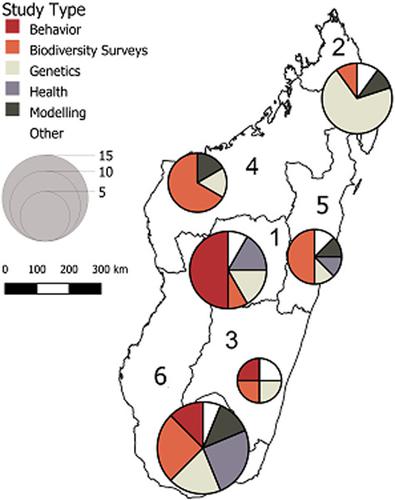当前位置:
X-MOL 学术
›
Am. J. Primatol.
›
论文详情
Our official English website, www.x-mol.net, welcomes your
feedback! (Note: you will need to create a separate account there.)
Trends in forest fragment research in Madagascar: Documented responses by lemurs and other taxa.
American Journal of Primatology ( IF 2.0 ) Pub Date : 2020-01-20 , DOI: 10.1002/ajp.23092 Katherine J Kling 1 , Kimberley Yaeger 2 , Patricia C Wright 2, 3
American Journal of Primatology ( IF 2.0 ) Pub Date : 2020-01-20 , DOI: 10.1002/ajp.23092 Katherine J Kling 1 , Kimberley Yaeger 2 , Patricia C Wright 2, 3
Affiliation

|
The rise in research investigating fragmentation and its impact on primates and other taxa reflects the growing presence of fragmented landscapes themselves. Although numerous studies report the negative effects of fragmentation on biodiversity, it is difficult to generalize responses to fragmentation for specific taxonomic groups, such as non-human primates, when studies have not employed a definitive concept of fragmentation or fragments themselves. Madagascar's high degree of fragmentation, wealth of endemic taxa, and extensive history of ecological research provide the opportunity to compare fragmentation studies across similar contexts. We conducted a literature search of peer-reviewed articles on fragmentation in Madagascar to characterize its trends. A total of 70 articles, 46 of which concentrated on lemurs, tested the impacts of fragmentation on Malagasy taxa, while additional sources conducted research in one or more fragments without testing its effects (n = 112 total, 79 on lemurs). Studies on lemurs most frequently tested fragmentation's impacts on genetics and biodiversity metrics (n = 16 and 15 studies, respectively), although health, modeling, behavioral, and cross-disciplinary techniques were also reported. Responses to fragmentation were reported for 49 lemur species, with most studies concentrated in eastern Madagascar (87%). Although there was variation in the metrics reported in studies testing the effects of fragmentation on Malagasy species, the most common measures were fragment area, isolation, or comparison to a control site. Landscape-scale approaches and examination of fragmentation per se were rarely employed. Characterizing trends of fragmentation research in Madagascar emphasizes the challenges of documenting fragmentation's effects while highlighting the benefits of research within fragmented landscapes, particularly when combined with consideration for how the matrix within human-modified landscapes may impact primate populations.
中文翻译:

马达加斯加的森林碎片研究趋势:有记录的狐猴和其他生物分类的反应。
研究破碎化及其对灵长类和其他类群的影响的研究的增加反映了破碎化景观本身的日益增多。尽管许多研究报告了碎片化对生物多样性的负面影响,但当研究未采用碎片化或碎片化的确定性概念时,很难归纳针对特定分类群(例如非人类灵长类动物)的碎片化反应。马达加斯加的高度碎片化,地方生物分类丰富,以及广泛的生态研究历史,为比较相似背景下的碎片研究提供了机会。我们在马达加斯加进行了同行评议的关于碎片化的文章的文献检索,以描述其趋势。共有70篇文章,其中46篇是关于狐猴的,他们测试了碎片化对马达加斯加生物分类群的影响,而其他来源则对一个或多个碎片进行了研究,未测试其影响(总共= 112,对狐猴为79)。对狐猴的研究最常测试碎片化对遗传学和生物多样性指标的影响(分别为16和15个研究),尽管也报告了健康,建模,行为和跨学科技术。据报道有49种狐猴对碎片反应,大多数研究集中在马达加斯加东部(87%)。尽管在测试碎片对马达加斯加物种的影响的研究中报告的指标存在差异,但最常见的衡量指标是碎片面积,隔离度或与对照位点的比较。很少采用景观尺度的方法和检查碎片本身。
更新日期:2020-04-13
中文翻译:

马达加斯加的森林碎片研究趋势:有记录的狐猴和其他生物分类的反应。
研究破碎化及其对灵长类和其他类群的影响的研究的增加反映了破碎化景观本身的日益增多。尽管许多研究报告了碎片化对生物多样性的负面影响,但当研究未采用碎片化或碎片化的确定性概念时,很难归纳针对特定分类群(例如非人类灵长类动物)的碎片化反应。马达加斯加的高度碎片化,地方生物分类丰富,以及广泛的生态研究历史,为比较相似背景下的碎片研究提供了机会。我们在马达加斯加进行了同行评议的关于碎片化的文章的文献检索,以描述其趋势。共有70篇文章,其中46篇是关于狐猴的,他们测试了碎片化对马达加斯加生物分类群的影响,而其他来源则对一个或多个碎片进行了研究,未测试其影响(总共= 112,对狐猴为79)。对狐猴的研究最常测试碎片化对遗传学和生物多样性指标的影响(分别为16和15个研究),尽管也报告了健康,建模,行为和跨学科技术。据报道有49种狐猴对碎片反应,大多数研究集中在马达加斯加东部(87%)。尽管在测试碎片对马达加斯加物种的影响的研究中报告的指标存在差异,但最常见的衡量指标是碎片面积,隔离度或与对照位点的比较。很少采用景观尺度的方法和检查碎片本身。











































 京公网安备 11010802027423号
京公网安备 11010802027423号